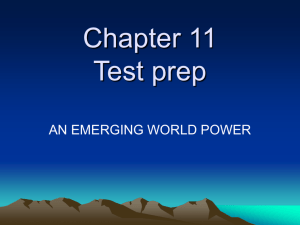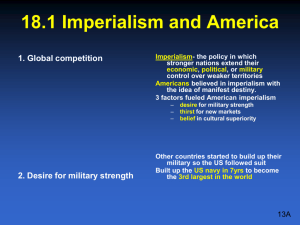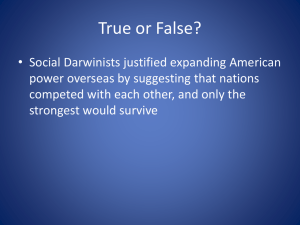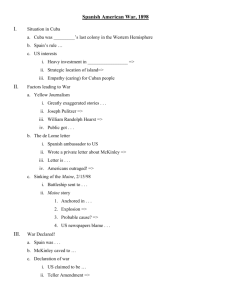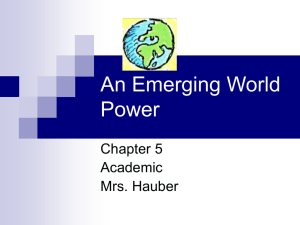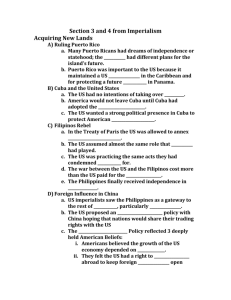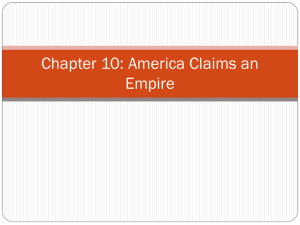18.1 Imperialism and America
advertisement
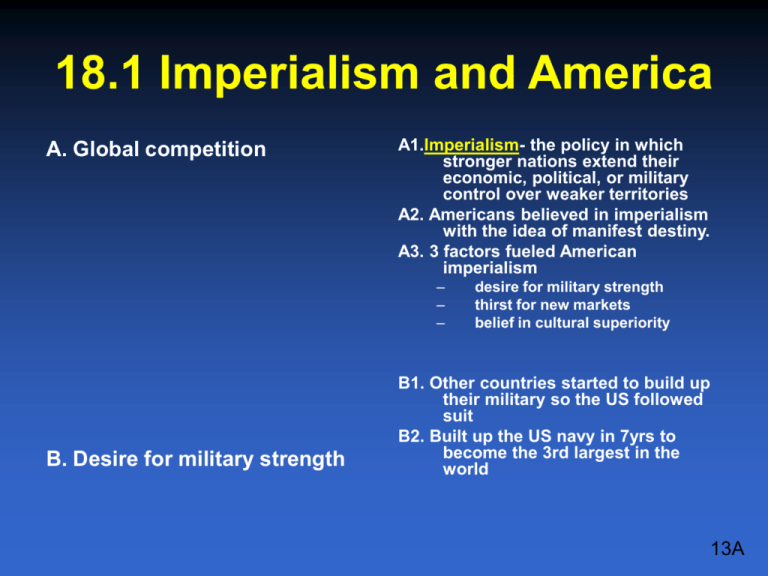
18.1 Imperialism and America A. Global competition A1.Imperialism- the policy in which stronger nations extend their economic, political, or military control over weaker territories A2. Americans believed in imperialism with the idea of manifest destiny. A3. 3 factors fueled American imperialism – – – B. Desire for military strength desire for military strength thirst for new markets belief in cultural superiority B1. Other countries started to build up their military so the US followed suit B2. Built up the US navy in 7yrs to become the 3rd largest in the world 13A US NAVY Great White Fleet’s Route C. Thirst for new markets D. Belief in cultural superiority E. Cry for annexation C1. US was overproducing certain goods so they looked to other countries for trade D1. US believed in cultural, racial, and religious superiority over weaker countries E1. Hawaii produced the main sugar supply for the US in 1875 b/c it was duty free E2. McKinley Tariff of 1890 revoked the duty free status of Hawaii which meant Hawaii now faced competition in the US market E3. US pressured Hawaii to build a naval base at Pearl Harbor 6A F. End of a monarchy F1. US ambassador overthrew Queen Liliuokalani and setup a govt. run by senator Dole F2. President Cleveland recognized the republic of Hawaii but refused annexation unless a majority of Hawaiians wanted it F3. 1898 congress proclaimed Hawaii an American territory 18.2 The Spanish-American War A. American interest in Cuba A1. 1854 President Pierce tried to buy Cuba from Spain, but they refused A2. US helped Cuba to fight for freedom from Spain, but it failed B. Headline wars B1. Yellow journalism – style of writing that American journalist used to show the brutality of the Spanish to Cubans. It exaggerated the news to lure and encourage readers 8A / 7D Yellow Journalism C. The De Lome letter C1. De Lome letter criticized the American president and made more Americans sympathize with the Cubans D. USS Maine explodes D1. Ship blew up in the harbor of Havana D2. 260 men killed D3. No one knows why the ship exploded D4. Newspapers claimed that the Spanish blew up the ship E. War in the Philippines E1. 1st battle of the SpanishAmerican war was fought on the Philippine Islands E2. George Dewey with American troops and Filipino rebels fought for the independence of the Philippines E3. Spain surrendered F. The war in the Caribbean F1. US placed a blockade on Cuba F2. US army was weak G. Rough Riders G1. Rough Riders – Volunteer cavalry under the command of Teddy Roosevelt G2. San Juan Hill – Rough Riders cleared the way for the victory 2 days later the war was over H. Treaty of Paris I. Debate over treaty H1. US + Spain signed an armistice H2. Treaty of Paris – Spain freed Cuba and turned over Guam + Puerto Rico to the US H3. Spain also sold the Philippines to the US for 20 million I1. Debate over if the US had the right to annex the Philippines I2. 1899 congress approved the annexation of the Philippines 2D / 8D Rough Riders 18.3 Acquiring New Lands A. Return to civil govt. A1. Foraker act- ended military rule in Puerto Rico and set up a civil govt. A2. Act gave power to the US presidents to appoint governors and members of the upper house A3. Gave the right for Puerto Ricans to be US citizens B. American soldiers B1. US controlled Cuba the same as Spain B2. US provided food, clothing, gave people land, and organized schools C. Platt Amendment C1. Cuba wrote its own constitution C2. Since they did not specify a relationship with the US, the US added the Platt amendment – – – Cuba could not make treaties that limited its independence Cuba was not to go into debt US could buy or lease land for naval stations C3. Cuba was a US Protectorate- a country whose affairs are partially controlled by a stronger power D. Philippine-American war E. Aftermath of the war D1. Filipinos rose up against the US D2. US had harsh control over the Island which killed many Filipinos E1. Set up a govt. similar to that in Puerto Rico E2. Philippines would eventually become an indep. republic 4D F. John Hay’s open door notes G. Boxer rebellion in China F1. Letters addressed to the leaders of imperialist nations proposing that the nations share their trading rights with the US F2. No single nation would have a monopoly F3. Create an open door policy with China G1. Europeans dominate China’s trade G2. Boxers were anti-Christian and European G3. Army of foreign troops marched to the capital putting down the boxer rebellion H. Protecting American rights H1. US pledge to protect China H2. US depended on exports H3. Us had a right to intervene abroad to keep foreign market open H4. They feared that the closing of an area to American products, citizens, or ideas threatened US survival 3A 18.4 America as a World Power A. Roosevelt the peacemaker B. Panama Canal A1. Roosevelt helped negotiate the peace treaty b/w Russia and Japan A2. Won the noble peace prize B1. US needed a canal that cut across Central America B2. US had to get permission from Colombia who ruled Panama B3. This called for a Panamanian rebellion against Columbia 11A Roosevelt in Latin America C. Constructing the canal D. Roosevelt Corollary C1. Cost 380 million C2. Took ten years to build the canal D1. Many Latin American countries had borrowed money from European countries to build RRs D2. Roosevelt thought European countries would try to reclaim their lands D3. Roosevelt Corollary- US would use force to protect its economic interest in Latin America D4. Big Stick Diplomacy - willing to use military force E. Dollar Diplomacy E1. Using the US govt. to guarantee loans made to foreign countries by American business (Taft) F. Moral Diplomacy (Missionary Diplomacy) F. Moral obligation- US was to promote moral progress in world. (Wilson) 12D / 10A / 9D
